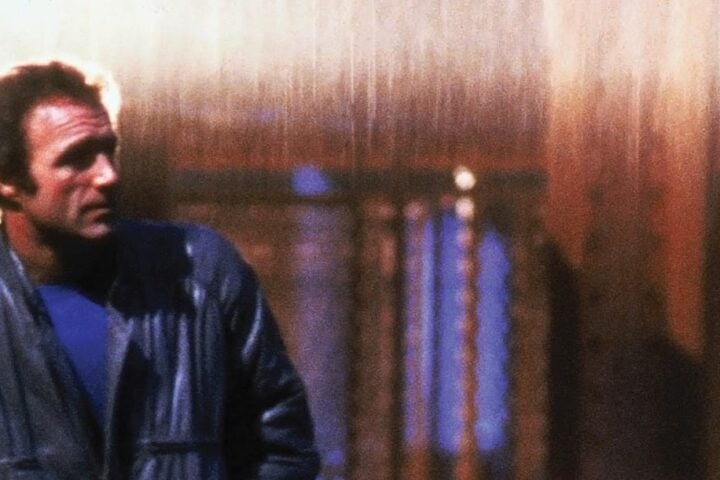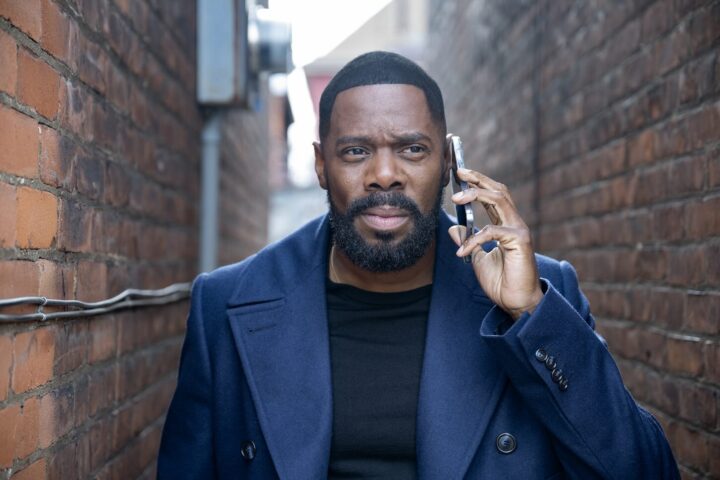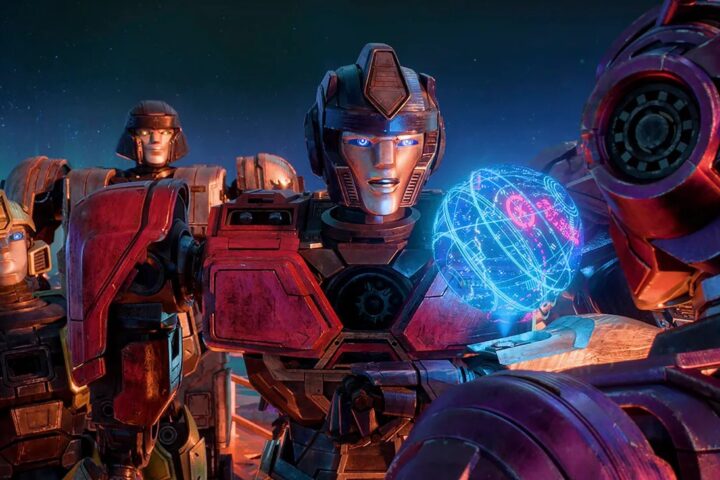The first notable images in Blackhat are of a synchronized series of white lights, flashing rapidly as digital poison courses through the inner workings of a computer mainframe, the camera trailing along on this tumbling journey through the darkness. This is a scarcely graceful bit of eye-catching CG spectacle, seemingly injected to enliven the usually drab proceedings of the hacker movie, a subgenre of thrillers in which fleet-fingered desperadoes are prone to squaring off against one another across the bland conduit of static computer prompts. Yet despite a fair share of clunky elements, director Michael Mann’s elegant work ultimately elevates the film above the level of the material, turning that initial image—of light and dark contrasted within a seemingly all-encompassing grid, its rigidity offset by a sinuous flow of wordless movement—into a gracefully expanding visual motif.
Utilizing a variety of flourishes stemming from agile, expressive camerawork courtesy of Stuart Dryburgh, the veteran action auteur upgrades what could have easily been a piece of high-concept junk given the uneven screenplay and the gruff, clumsy central presence of Chris Hemsworth into a stylish, tautly constructed thriller. Hemsworth is never entirely convincing as imprisoned genius hacker Nicholas Hathaway, but he does work fabulously as a chunk of human marble, hurtled through a series of inventively shot, fluidly frenetic set pieces. Meanwhile, the heavy dramatic lifting is handled by an able supporting cast, with key contributions from Viola Davis to Chinese actress Wei Tang and Mann regular John Ortiz, their facility with inane dialogue helping to compensate for Hemsworth’s shaky performance.
The film’s title refers to the nominal distinction between white-hats and black-hats, those hackers supposedly serving the public good and those intent on seeding chaos for personal gain. Beyond its connection to the movie’s binary fixations, this terminology also conveniently borrows from the old-fashioned western, whose traditions are also consciously updated through a rollicking chase structure in which the one-time bad guy is given a second chance to make good, facing off against cheap shots and double-crosses from all sides.
Serving a 13-year sentence for hacking banks, Hathaway gets sprung after a Chinese task force, headed by a former MIT roommate (Leehom Wang), demands his expertise to track down the mysterious figure pulling high-wire acts of terrorism. Using malicious code to create mischief in the physical world, he first overheats a Hong Kong nuclear reactor, then progresses to screwing with the stock market, hiding his identity behind a web of human and digital proxies.
Through all this the story maintains its straightforward momentum, emulating the globe-trotting thrills and intellectual ennui of the Bourne movies, while the texture of the film bends and twists around it. Verging further and further into the hazy nocturnal netherworld familiar from previous Mann movies, it attains a dreamlike languor as the basic landscape of ones and zeroes, good guys and bad, steadily gives way to an atmosphere of layered ambiguity.
Blackhat is at its best when no one is speaking, in the crisp staging of a hectic chase or the compressed tension of a thudding fistfight, with the director using his camera like a paintbrush, applying a soft-focus palette of smeared city lights and streaky movement onto a canvas of deep, inky darkness. Shooting fully in digital for the first time, Mann expands on the woozy handheld work that made Collateral and Miami Vice so tactile and entrancing, his camera collapsing the spaces between bodies and objects without sacrificing spatial coherence, creating an artfully abstract collective muddle as neatly structured systems collapse into one another.
All this feeds into a general ambiance of post-9/11 unease, with burnt-out public guardians hopelessly hunting enemies who could be coming from anywhere, the dangers of terrorism eventually equated with the voracious machinations of financial string pullers, borders and restrictions rendered meaningless by this new state of play. Through it all, Mann thankfully realizes how little tension there is to extract from the sight of people typing furiously at each other, and so the film wisely relegates these scenes to the sidelines of niftily staged pursuit scenarios, the digital world left behind for a series of sweaty “low-tech” maneuvers.
It’s in the last of these that Blackhat’s subtle connection between form and content becomes thrillingly evident, with the final transposition of the gridded circuit motif onto a sprawling Indonesian parade. Here, in a blur of color and movement, Mann offers a climactic revelation of individual faces behind all those abstract binary data points, anonymous digital matter transformed into something achingly fragile, fleeting, and human.
Image/Sound
Filmed using multiple types of digital cameras, Blackhat deliberately lacks a unified look, but Arrow’s Dolby Vision-boosted 4K maximizes the fine detail, subtle light gradations, and deceptively rich colors of the film’s naturalistic cinematography. Skin tones reveal the subtlest of discolorations, while the nighttime exteriors shot with available light retain all the clarity afforded by digital. The disc comes with the original lossless audio, which ably mixes street noise and Michael Mann’s trademark live-miked gunshots and explosions across a wide field of channel distribution, but the theatrical cut’s at times muddied dialogue is still noticeable.
A separate 2K Blu-ray comes with the film’s director’s cut, previously shown only on TV and kept alive primarily through the rare repertory screening and bootlegs. It’s an undeniable disappointment that this version, which runs roughly the same length as the theatrical version but is massively re-arranged and given some needed audio mix tweaks that result in a more taut and logically ordered thriller, isn’t included in UHD. Nonetheless, this release didn’t initially feature the director’s cut, and Arrow delayed the disc by nearly half a year to iron out the rights that were necessary to include it here, so to finally have this version in an official capacity is a major coup. The Blu-ray looks almost as strong as the theatrical 4K.
Extras
Arrow offers a newly recorded commentary track by critics Bryan Reesman and Max Evry, who err too often on the side of trying to be funny, with awkward jokes cracked at the film’s expense amid some genuinely informative observations and production details. Far more rewarding are new interviews with production designer Guy Hendrik Dyas and cinematographer Stuart Dryburgh. The former extols Mann’s extensive research and clear vision, even talking fondly about how at times he became the director’s glorified assistant on set. For his part, Dryburgh offers an accessible 20-minute lecture on the positive attributes and new possibilities of digital filmmaking. He explains the technical capabilities of the Arri Alexa camera that served as the main shooting platform for the film, as well as details how other digital cameras were used depending on the needs of a given setup. Arrow also ports over three brief making-of featurettes that first appeared on teh original 2015 Universal Blu-ray of the film.
Overall
Bolstered by a host of informative extras and the 11th-hour inclusion of the vaunted director’s cut, Arrow’s 4K does right by this cyberthriller’s small but hardcore fanbase.
Since 2001, we've brought you uncompromising, candid takes on the world of film, music, television, video games, theater, and more. Independently owned and operated publications like Slant have been hit hard in recent years, but we’re committed to keeping our content free and accessible—meaning no paywalls or fees.
If you like what we do, please consider subscribing to our Patreon or making a donation.



